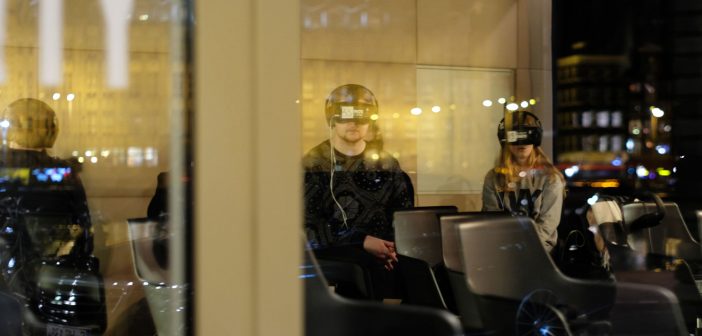- Perhaps some more than others

The world currently seems very full of two-letter acronyms, all surrounded by a huge amount of hype. But which will actually change the world, and which will turn out to be niche interests, best left to serious gamers or programmers?
Read any kind of predictions article for 2018, and you are bound to find at least one two-letter acronym. The ‘big four’ are probably:
- AI – artificial intelligence
- ML – machine learning
- AR – augmented reality
- VR – virtual reality
There is, of course, considerable overlap between these four, and they can also be used in combination to produce new experiences for consumers or customers. But for the moment, let’s keep them separate and consider how each one could be used in business, especially in retail, over the next few years to ‘change the world’.
Four ways to change the world
Artificial intelligence has been around for a while, and is closely linked to machine learning. It describes computers that can act, or seem to act, intelligently. One of the biggest possible uses in retail is in online or post-sales customer service, particularly through chatbots.
The use of chatbots has focused on standardising service provision, and freeing up human time to concentrate on more complex interactions. The cynic in me sees a commercial benefit in reducing labour costs, but there is also no doubt that early use cases, often in banking, involve human–machine partnership, with humans having to step in quickly when the conversation gets complex. This, therefore, has been about improving customer experience without increasing costs, rather than reducing costs.
Whether you are a data scientist, business sponsor or IT facilitator, the coming AI-driven transformation demands you keep pace with possibilities. Join fellow innovators at Analytics Experience, and learn from a mix of thought leadership driven discussions, concrete case studies and hands-on workshops.
Machine learning is a similar concept to AI. AI, as the idea that machines can act intelligently, is probably the broader concept. Machine learning is the idea that machines should be able to learn for themselves given access to enough data. This might sound like the territory of geeks, but it could also be a way to deliver personalised recommendations and solutions in the future. It is already being used in retail — recommendations engines like Amazon’s, for example, often use some form of ML to learn from your preferences and deliver more accurate recommendations in future. This type of engine often needs quite a lot of training, with plenty of input from the person on the receiving end of recommendations. This has already changed the way we shop, and could have further impact in future.
Augmented reality and virtual reality are very similar, and the terms are often used interchangeably by the uninitiated. Virtual reality is the use of headsets to shut out the world, and enter a different reality. Augmented reality is an addition to reality while you remain in the world. One commentator suggested that if virtual reality enabled you to swim with sharks, augmented reality allowed you to watch a shark pop out of your business card.

AR is not the newest kid on the block by any means, and some retailers were experimenting with it around five years ago. However, it has come a long way since then, and the rapid increase in access to mobile devices, and the number of new devices that can use AR, mean that it may become more mainstream. It might be useful in planning home interiors, and looking at what a product might look like in the home, or even just making the retail experience a bit more fun. Pepsi, for example, showed the use of this technology by adding a panel to a bus stop, startling commuters with sights of tigers and aliens roaming the streets. Its routine commercial application, however, may take a little longer to emerge.
Virtual reality is probably even more limited. The headsets are quite expensive, but I also think that the experience is a little too isolating for the user. It is hard to find many commercial uses for the experience beyond gaming. In retail, I think the best uses are likely to be in analysis or planning of stores by head office but even there, I think it is fairly limited.
Beyond the buzz of what artificial intelligence can do, how will AI change companies and the way they are managed? Learn more from this HBR collection.
Predicting changes
The difficulty with making predictions is the potential for it all to go horribly wrong. But it is the right time of year, after all, so here goes. I do not think that virtual and augmented reality will make that much difference in retail this year, at least, and possibly not for the next few years. On the other hand, I am excited by the potential of both machine learning and AI. I will be watching developments in this area closely.
There is no doubt that #AI involve human–machine partnership, with humans having to step in quickly when the conversation gets complex. #AR #VR #ML Click To Tweet

8 Comments
Nice article Andrew. Nobody can deny the world is being transformed at a remarkable rate. I agree it's tough to make an accurate description of where this is headed. That said, many industries are benefiting massively from these kinds of technologies. It will be interesting to see where we're at in 20-30 years!
Hi Andrew. It's really nice article. I am very much interested to know about AR and VR. These technologies will definitely grab the attention of entire world.
Hi Andrew - not sure what the protocol here is but i'm writing an article on the evolution of technology and was wondering if it was OK to insert a link to your article as it would be a great fit. It is being published in a magazine called Inside Strata which is distributed in Australia.
regards
Matt Larwood
Hi Matt, Yes feel free to link to it , glad its useful to you ! Andrew
Thanks for the article! Hey, you forget about Mixed Reality. It is a hybrid definition that blends aspects of both VR and AR. Mixed reality is the next evolution in human, computer, and environment interaction and unlocks possibilities that before now were restricted to our imaginations.
Hi Andrew! Nice article. Definitely, AR is becoming a real web design trend as it grants a better experience for the e-commerce websites. Customers obtained the possibility to see more precisely how the product will look like in real life. All user need to have is just a web or smartphone camera.
Thanks for the comment, and yes I do think AR has become more relevant for a number of areas during the Crisis- seeing more examples of good uses cases with mobile devices to experience how home interiors and even Car interiors might look and 'Feel'.
I think this is an informative post and it is very useful and knowledgeable. Keep up the good work.